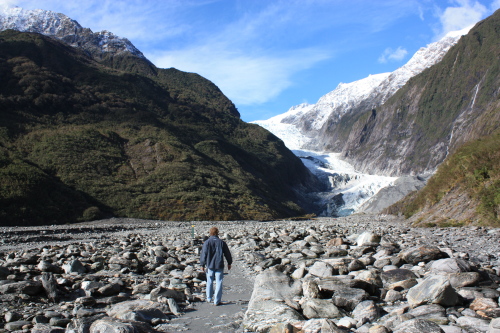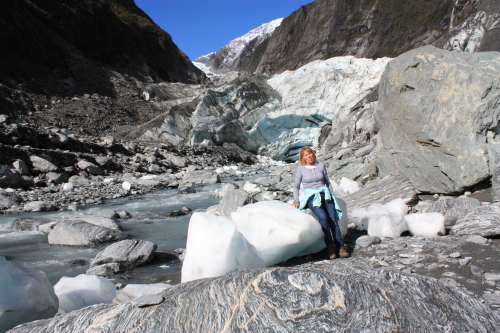Franz Josef Glacier

Jackamy
Paul & Derry Harper
Sun 22 Aug 2010 00:43
|
Sunday 22nd August
The early Maori knew Franz Josef as Ka
Roimata o Hine Hukatere ( Tears of the Avalanche Girl ). Legend tells of a girl
losing her lover who fell from the peaks, and her flood of tears freezing into
the glacier.
We spent two days at the village of Franz
Josef and on Sunday a crisp sunny morning we visited the glacier.
Franz Josef and Fox Glaciers are part of the
Tai Poutini National Park. Nowhere else at this latitude do glaciers come so
close to the sea.
The glacier is currently 12 km long
and terminates 19 km from the Tasman sea. Fed by a
20 square kilometers (7.7 sq mi) large snowfield at high
altitude, it exhibits a cyclic pattern of advance and retreat, driven by
differences between the volume of melt water at the foot of the glacier and
volume of snowfall feeding the neve. Due to strong
snowfall it is one of the few glaciers in New Zealand which is still growing as
of 2007, while others, mostly on the eastern side of the Southern
Alps, have been shrinking heavily, a process attributed
to global warming.
Having retreated several kilometers
between the 1940s and 1980s, the glacier entered an advancing phase in 1984 and
at times has advanced at the phenomenal (by glacial standards) rate of 70 cm a
day. The flow rate is about 10 times that of typical glaciers. Over the longer
term, the glacier has retreated since the last ice age,
and it is believed that it extended into the sea some 10,000 to 15,000 years
ago.
This cyclic behavior is well illustrated by
a postage stamp issued in 1946, depicting the view from St James Anglican
Church. The church was built in 1931, with a panoramic altar window to take
advantage of its location. By 1954, the glacier had disappeared from view from
the church, but it reappeared in 1997. This is due to the highly variable
conditions on the snowfield, which take around 5-6 years before they result in
changes in the terminus location.
Based on past variations, scientists expect that Franz Josef Glacier will retreat 5 km and lose 38% of its mass by 2100 in a mid-range scenario of global warming.      I think Paul has a liking now
for danger..............................Me stood on the glacier
  The glacier face
..................................if only I could get these ice cubes back to
the boat
  A view looking where the
glacier used to be and some spectacular waterfalls
|